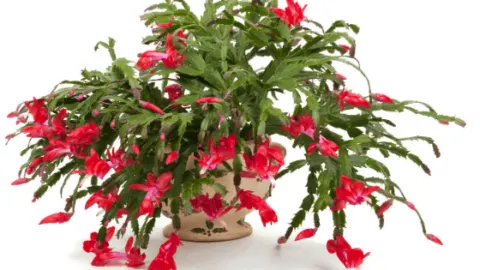I will cover everything you need about Christmas cactus care in this article.
The Christmas cactus goes by the botanical name Schlumberga x buckleyi and is a hybrid between Schlumbergera truncata and Schlumbergera russelliana.
According to Missouri Botanical Garden it is a perennial cactus with flat stems that blooms in winter. It is frost-intolerant.
The plant originates from the coastal mountains of southeastern Brazil. You can find these cacti in places like Rio de Janeiro and Sao Paulo. It likes moist and humid conditions and needs plenty of water to bloom. They even grow on rocks and small mossy trees and are often sold during the holiday season.
They are often sold with flower buds that are ready to produce blooms.
Christmas Cactus Takeaways
| Species | Schlumberga x buckleyi |
| Synonyms | Christmas Cactus,hanksgiving cactus,crab cactus,Holiday cactus |
| Family | Cactaceae |
| Genus | Schlumbergera |
| Growth | arching, weeping, rounded |
| Height | 0.8 feet |
| Width | 2 feet |
| Soil | Well-draining soil using potting soil, compost, perlite, milled peat |
| Watering | Water every 14 to 21 days |
| Light | Bright indirect |
| Temperature | 60 to 70°F |
| Humidity | 50-60% |
| Fertilizer | Fertilize 1 times per month |
| Propagation | Stem cuttings |
| Toxicity | Non toxic to humans and pets such as cats and dogs. The plant material however can cause vomiting and diarrhea if ingested in large quantities. |
Table of Contents
Christmas cactus Care
Provide well-draining soil using potting soil compost, perlite, and milled peat, as well as bright indirect light. Water every 2-3 weeks once the top 1-inch of soil is dry (5cm). The ideal temperature lies between 60°F to 70°F (16°C – 21°C), and the perfect humidity lies between 50-60%. Fertilize between April-October every 2-3 weeks.
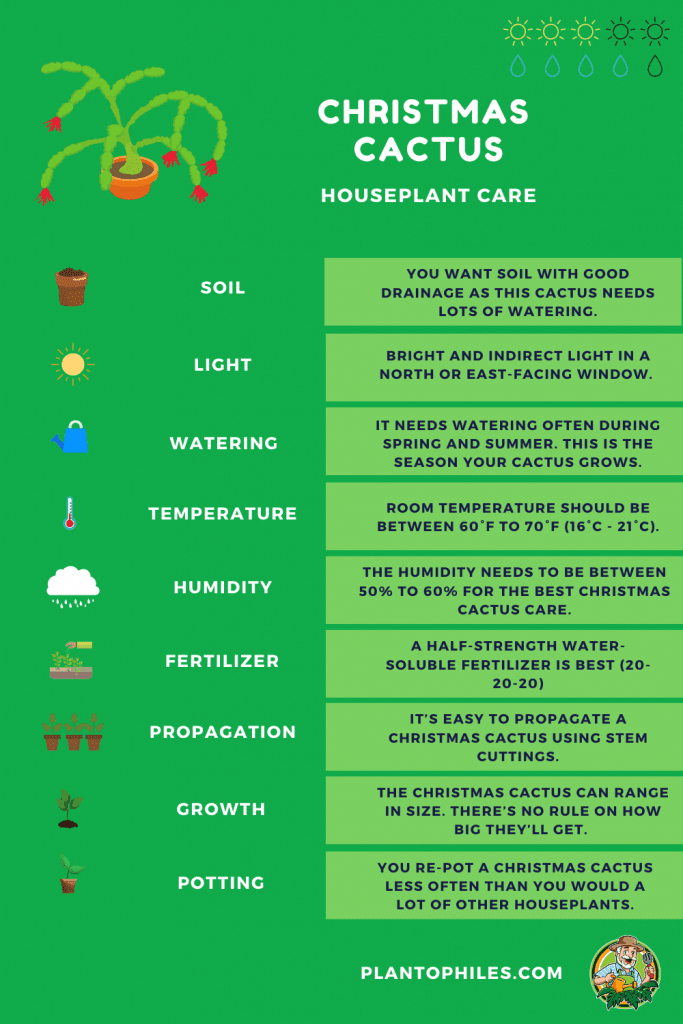
Christmas Cactus Care Video
Christmas Cactus Growing Guide
1. Soil
The Christmas cactus is an epiphyte and needs well-draining soil.
Being an epiphyte, it grows on rocks, on small trees covered in moss, and on the trunks of big trees.
So, it doesn’t get its’ hydration from the soil. Most of the moisture it gets is from the humid air.
But that heavy humid air provides it with lots of moisture. These cacti need plenty of water for a healthy life.
Lots of water means you need soil that has great drainage. Without that drainage, the water will build up in the soil. Too much moisture can lead to our enemy, wet feet.
There are plenty of potting soils on the market with everything you need. They have a mix of peat and leaf mold.
The perfect potting mix is a regular cactus mix containing:
- potting soil
- compost
- perlite
- milled peat
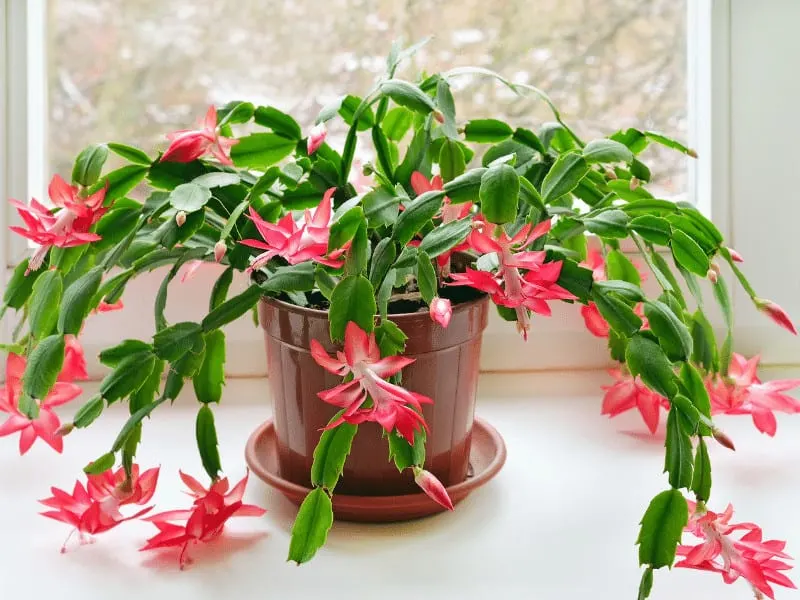
2. Light
A Christmas cactus grows best in bright indirect light.
They are sensitive to too much direct light. Avoid bright direct light for more than 6 hours a day.
If it cannot sufficiently hydrate, the leaves can burn in conjunction with too much sunlight.
A sign of too much sun exposure is the stem turning red. Insufficient light exposure means the cactus won’t flower.
An east-facing window is ideal.
An east-facing window provides 4-6 hours of direct sunlight in the morning and bright indirect light throughout the rest of the day. Read my guide on light levels for plants.
3. Watering
Water your Christmas cactus every 2-3 weeks once the top 1 inch of soil is dry to the touch (5cm).
A Christmas cactus needs more humidity than other succulents.
When you water, wait until the soil is almost dry so the water doesn’t build up. It is a good rule of thumb to keep the soil slightly on the dry side.
To check how moist the soil is, stick your finger in the soil up to your knuckle. If the top 1 inch is dry (5cm), it’s time to water.
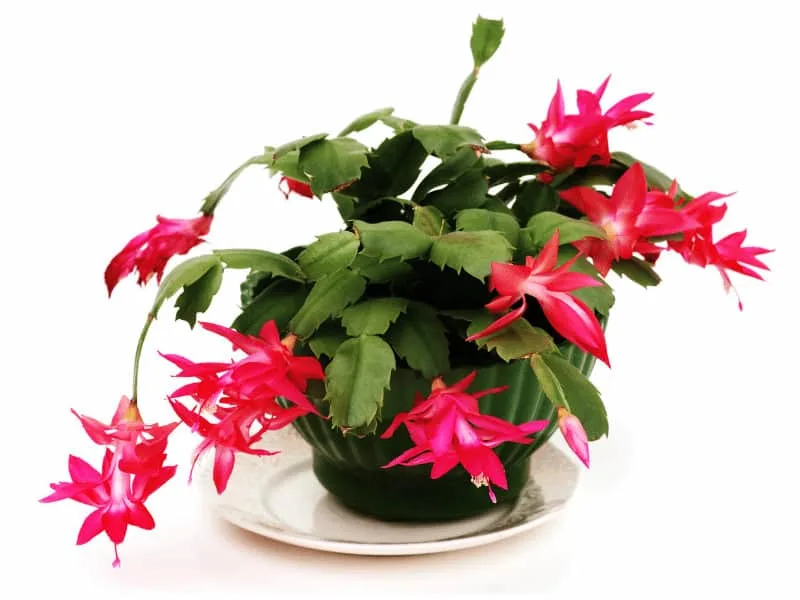
4. Temperature
During the day, the room temperature should be between 60°F to 70°F (16°C – 21°C) for a Christmas cactus. At night, the temperature should be between 50°F to 55°F (10°C – 13°C).
5. Humidity
The ideal humidity for Schlumberga x buckleyi lies between 50% to 60%.
It originates in Brazil, where the humidity is crazy high. And even as a houseplant, the room’s humidity must be high.
If you’re having problems creating the right humidity, you can try the pebble tray method.
Take a tray and fill it with pebbles. Then you fill it with water until it’s sitting right underneath the pebbles. Place your plant pot on the pebbles.
As the water evaporates, it rises and creates humidity for your plant. And when the water is all gone, you only have to refill it.
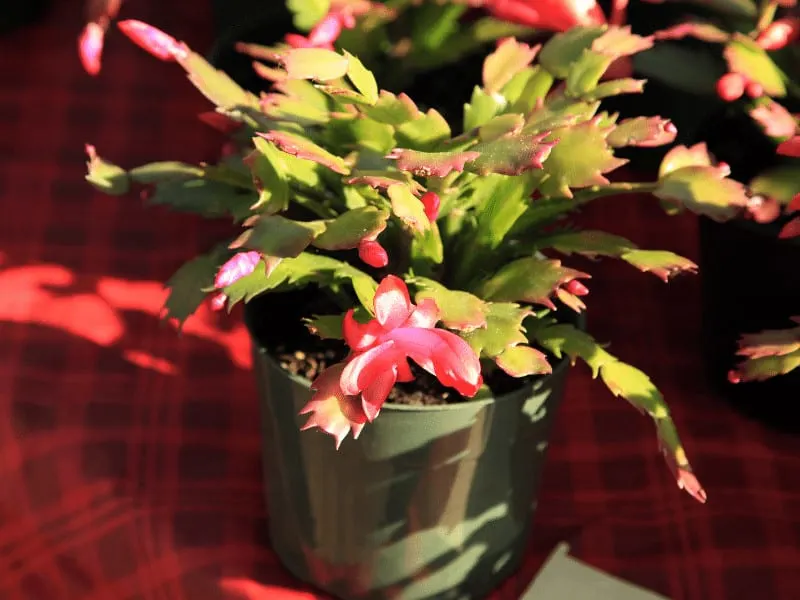
6. Fertilizer
Fertilize a Christmas cactus every 2-3 weeks from Spring to Summer. Do not fertilize between fall and winter.
If fertilized insufficiently, the joints will break apart when it lacks the right nutrients.
Use a half-strength water-soluble houseplant fertilizer. Read everything about fertilizers in my complete guide.
It should have equal amounts of nitrogen, phosphorus, and potassium.
Leaf growth happens between April to October. It starts blooming in November.
But you have to stop fertilizing in late September. You don’t want to fertilize your cactus when the flowers start to bud or they will fall off your plant.
When you fertilize when it’s not growing, salt builds up in the soil. This leads to either the buds not producing at all or the buds falling off.
Your cactus needs more magnesium than most fertilizers have to offer. You can mix a teaspoon of Epsom salt per gallon of water to get this extra magnesium. Add the Epsom salts every other time you water.
7. Propagation
It’s easy to propagate a Christmas cactus using stem cuttings.
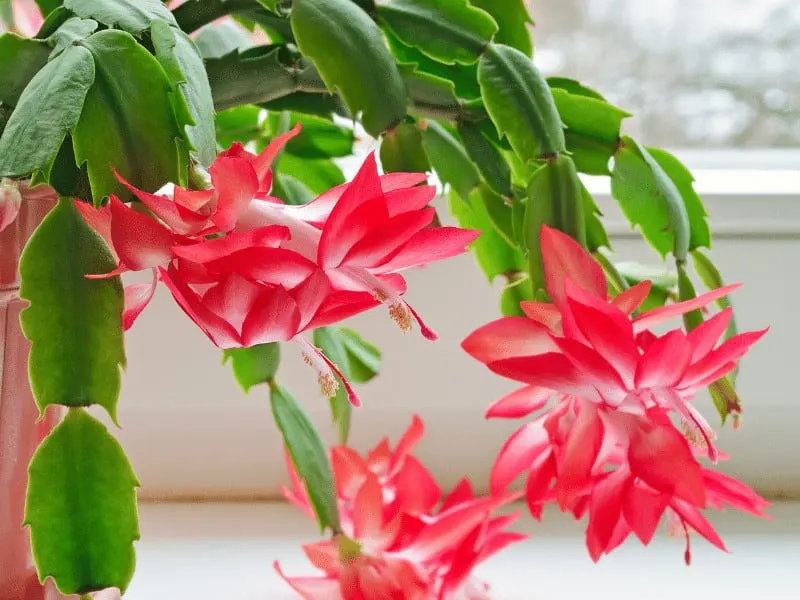
8. Growth
The Christmas Cactus grows up to 10 inches in height (25cm) and 24 inches in width (61cm).
You’ll notice that most of the time, this plant won’t grow much in height. It grows in width, as do its hanging branches.
The hanging branches can grow up to three feet long. The width of the rest of the plant usually expands somewhere between six inches and ten inches.
9. Potting
You repot a Christmas cactus less often than you would a lot of other houseplants. Repot every three years.
You don’t want to re-pot it right when the roots expand. Unlike most plants, these cacti feel comfortable with crowded roots.
It makes the cactus feel grounded. It also creates the best situation for the flowers to bloom.
Repotting is done after the plant has finished blooming. Trying to repot a blooming cactus can ruin the entire blooming process.
Most Christmas cacti stop blooming around late winter, sometimes early springtime.
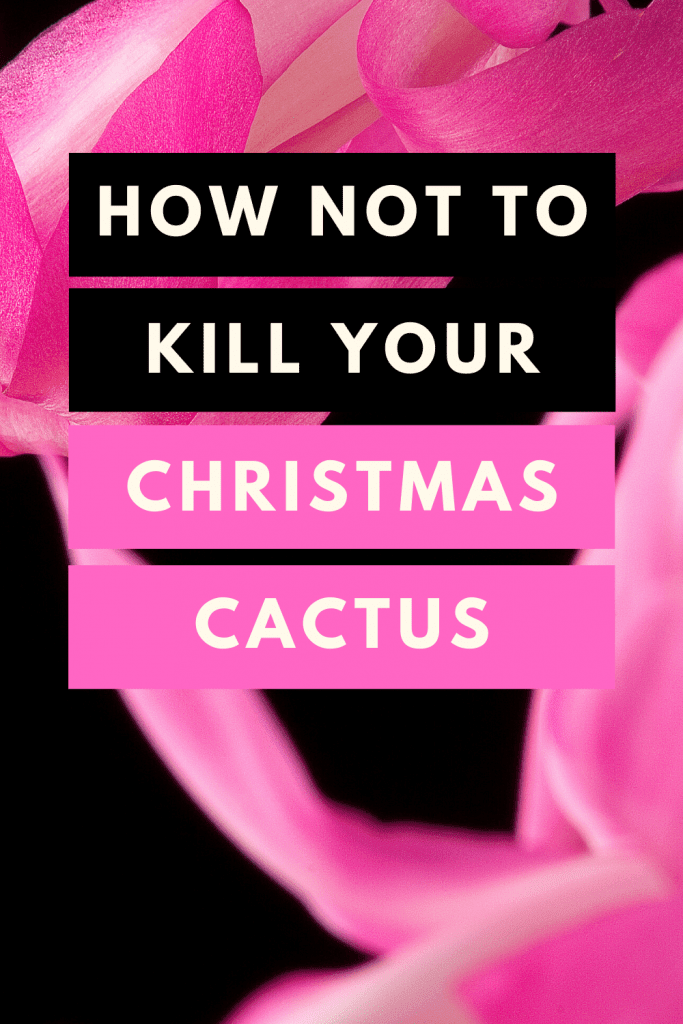
Bloom
For the flowers to form, a Christmas cactus needs at least 12 hours of darkness when the temperature is between 60°F to 70°F (16°C – 21°C).
It should get about 16 hours of darkness daily when the room temperature is over 70F.
When the plant goes through the dark cycle of the day, it needs complete darkness.
If a dark room isn’t possible, you can cover your cactus up at night.
Christmas Cactus Propagation Steps
- Your very first step is to gather the cuttings. You’ll need pruning shears instead of your normal household pair of scissors. You clip the top Y-shaped cutting from the tip of the stem. Cut down to two or three segments.
- Once your cuttings are ready, let them dry for two or three days. It would be best if you placed them in a cool room. Letting them sit out and dry allows them to form a callus on the cut end.
- In the meantime, get your soil and pot ready. Try making your soil if you want to get dirty and more hands-on. The best soil mix includes normal potting soil, compost, perlite, and milled peat. The pot should have drainage holes at the bottom. Pour the soil out into the pot.
- Now that the cuttings are ready to go, you will start the rooting process. Place your cutting in the soil mix you created. It should sit about a quarter inch below the soil.
- Place your cuttings where it can get bright but indirect sunlight. At this point, you don’t want to water the cutting or cuttings too much.
- After about two weeks, you’ll notice the tip of the leaves starts growing. They’ll start to turn red. This is a sign that the rooting has begun.
- Once you’ve finished most of the rooting, you’re on your way to a beautiful budded Christmas cactus. You’ll start caring for it as you would if you bought it as a full-grown plant.
Varieties of Holiday Cacti
There are two other cool holiday cacti to consider related to the Christmas cactus:
Rhipsalidopsis gaertneri (Easter Cactus)
The Easter cactus always blooms in springtime. It’s a gorgeous cactus with gorgeous pink (sometimes orange or red) flowers. The pink flowers hang from the flat, segmented leaves.
Schlumbergera truncata (Thanksgiving Cactus)
The Thanksgiving cactus blooms in October or November. And it needs fewer daylight hours than the others. The leaves on this plant are broad and the edges are serrated.
Common Problems with the Christmas Cactus
They are not as prone to bugs as many other houseplants. It’s uncommon for an infestation though it does happen sometimes.
Mealybugs are one of the pests you might come across.
These bugs eat away at your cactus, and they eat any new growth. They hide out in the small spaces on your cactus. And they hang out on small white webs they weave.
Mealybugs spread fast so it’s important to get rid of them as soon as you discover them.
First, make sure your plant isn’t near any other houseplants so the mealybugs don’t spread.
Take a cotton swab and drip it in 70% isopropyl alcohol. Wipe your plant down, focusing on the areas where the branches and stem connect.
There are also root mealybugs. These mealybugs attack the roots and live in the soil. Repot your plant in new soil in case you spot root mealybugs.
You should also clean your plant with alcohol to make sure they’re not lingering on it.
Aphids are the second bug you have to worry about. These greenish pests are tiny and hard to see.
You want to get rid of them as fast as you can because they multiply quickly. And these bugs suck all the nutrients out of your plant.
Use isopropyl alcohol to clean all parts of your plant to get rid of aphids.
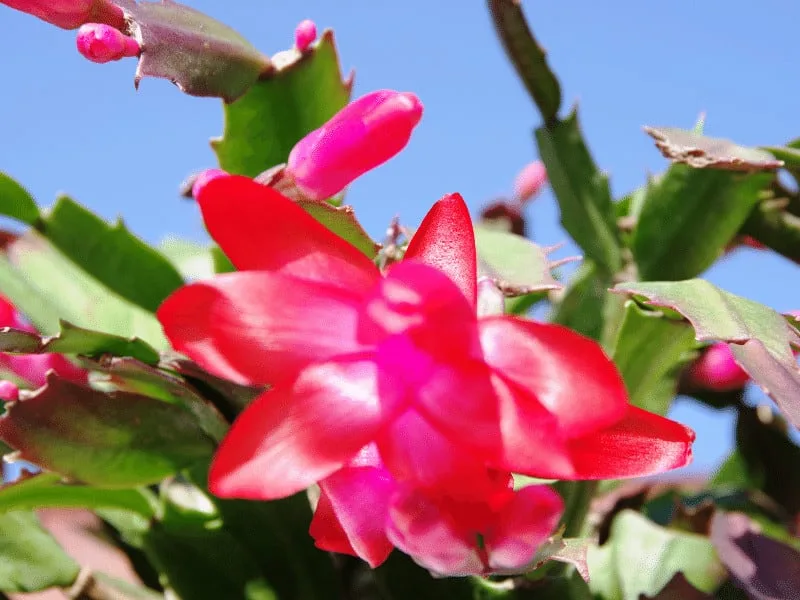
Tips for an Unhappy Christmas Cactus
Here are the common issues you might face:
Why are the Blooms Falling Off
Common reasons for blooms falling off are sudden temperature changes and an interruption of the min. 12 hours of night darkness, lighting level changes, and repotting during the blooming phase. Other reasons are incorrect watering (under or overwatering).
If your plant is dropping flowers, identify the correct cause and course-correct without overcorrecting. Eg, if your cactus is too dry, don’t water it too much immediately.
Gray Fuzzy Patterns on the Leaves
Botrytis blight is a common fungus for cacti. Too high humidity can cause spores. Since cacti need high humidity, it’s easy for the spores to develop.
The first thing you need to do is lower the humidity in the room. Then you must separate the infected plant from other plants, or it’ll spread.
Cut all the infected blossoms and infected areas from your plant right away. Mix two tablespoons of fungicide with a gallon of water.
Apply the mix to the entire plant. Make sure you coat it well.
In four weeks, reapply the same mix if you still see mold.
Yellow-Spotted Stem
A yellow-spotted stem has the virus impatiens necrotic spot virus or INSV.
The pest flower thrips pass INSV. They feed on an infected plant and move on to the next plant to feed. The virus is transmitted to the new plant.
This is a devastating virus and can kill your plant. As there is no cure, it is best to dispose of the plant immediately.
But you can protect your other houseplants from infestation by thrips. And thus protecting them from catching the virus the thrips transmit.
Separate all of the infected plants that have thrips on them.
Thrips are hard to see because they’re tiny creatures with wings. But you can get rid of them with insecticidal soap.
Gently wash your entire plants down with soap. Since thrips lay eggs, you’ll have to wash your plants again after 2-3 weeks to ensure you’ve gotten all the bugs.
Root rot
Root rot is a common reason your plant might not be doing well. You only need to water these succulents every 2-3 weeks, so it is easy to overwater. If the soil stays too soggy for too long, the only remedy is to take the plant out of the pot, change the soil and disinfect the pot.
Check the roots and cut off rotten roots. Wash the remaining roots under lukewarm water. Then replant it into the disinfected pot and add new potting soil.
Toxicity
The Christmas cactus is not toxic to humans and is pet-friendly. However, if it is ingested in large quantities, it can lead to vomiting and diarrhea because of the plant fiber. Therefore make sure to keep it away from children and pets.
What is the difference between a Christmas cactus and a Thanksgiving cactus?
The difference between a Christmas cactus and a Thanksgiving cactus is that the Thanksgiving cactus has claw-shaped edges on the leaf. In contrast, the Christmas cactus has teardrop-shaped edges on the leaves, according to Iowa State University.
Then there also is the Easter cactus (Rhipsalidopsis gaertnerrii) with its more rounded edges.
Frequently Asked Questions About Christmas Cactus Care
How do I prune my Christmas cactus?
Pruning a Christmas cactus can seem daunting because it’s unlike other houseplants. It’s easier. You can twist between each segment and pull to separate. Or you can cut between each segment.
Why won’t my Christmas cactus root in water?
It’s hard to root a Christmas cactus in water. Almost impossible. You’re better off rooting your cactus in soil.
Why won’t my Christmas cactus bloom?
When your buds form, it will be another 12 weeks until they bloom. You might be expecting them too early in the process. If that’s not the issue, reduce watering the cactus and ensure the room temperature is between 50F and 55F.
Can I revive my limp Christmas cactus?
There is a chance you can revive your Christmas cactus. Either your cactus is getting too much direct sunlight or not enough water. Up the amount of water you’re using and track it so you don’t over-water the cactus. And move your cactus from any direct sunlight.
Conclusion About Christmas Cactus Care
To care for a Christmas cactus:
- Soil: Well-draining soil using potting soil compost, perlite, and milled peat
- Light: Bright indirect light
- Water: Every 2-3 weeks
- Temperature: 60°F to 70°F (16°C – 21°C)
- Humidity: 50-60%
- Fertilizer: April-October every 2-3 weeks.

Daniel has been a plant enthusiast for over 20 years. He owns hundreds of houseplants and prepares for the chili growing seasons yearly with great anticipation. His favorite plants are plant species in the Araceae family, such as Monstera, Philodendron, and Anthurium. He also loves gardening and is growing hot peppers, tomatoes, and many more vegetables.

